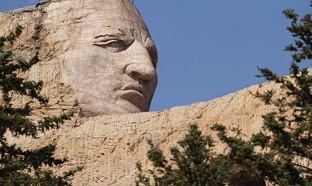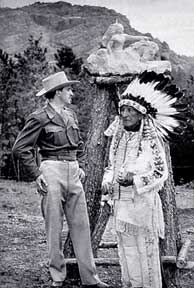

HISTORICITY |
|
By 1939, Gutzon Borglum was nearly finished with his work in western South Dakota. Four of America's most outstanding Presidents—George Washington, Thomas Jefferson, Abraham Lincoln, and Theodore Roosevelt—were masterfully carved on Mount Rushmore. "My fellow chiefs and I would like the white man to know the red man has great heroes, too," explained Sioux Chief Henry Standing Bear in his letter to sculptor Korczak Ziolkowski, urging him to visit the Black Hills. The Sioux wanted Ziolkowski to carve the likeness of Chief Crazy Horse atop Thunderhead Mountain, a relatively short distance from Mount Rushmore. Ziolkowski, who served for a short while as an assistant to Borglum on the Mount Rushmore project, eventually accepted the invitation. Work commenced in 1948, but not without controversy. As Ziolkowski made ready for preliminary blasting, a swell of opposition arose among South Dakotans to the Crazy Horse Monument being located in such close proximity to Mount Rushmore. Governor George T. Mickelson defended the site selection, sternly reminding the public that the Sioux were "...the people from whom we took this beautiful area—they had it first." No verifiable photographs exist of Crazy Horse. He refused to allow his spirit to be captured by the white man's strange device. Ziolkowski constructed a composite image of Crazy Horse from "word pictures" provided by Indians who knew him during his 34-year life. When finished, Ziolkowski's massive sculpture (641 feet long; 563 feet high) will dwarf Mount Rushmore. According to ambition, the three-dimensional carving will depict Crazy Horse bare-chested, mounted on a rambunctious horse, with an outstretched arm pointing in the direction from where the white men came to occupy the land inhabited by the Sioux. The arm gesture is part of his response to a question posed by a white fur trader: "Where are your lands?" Crazy Horse extends his arm eastward and answers: "My lands are where my dead lie buried." Upon Ziolkowski's death in 1982, his wife Ruth (herself once a worker on the mountain) and some of their children assumed management of the venture. Progress over the years has been painstakingly slow. Today, Crazy Horse is certainly recognizable, but still there is much rock yet to be shaped. The target date for completion is unspecified due to an irregular rate of work left to the mercy of random funding. Unlike Mount Rushmore, no government financing is accepted. Twice Ziolkowski rejected $10 million in federal funding. Ironically, the nearest town to Crazy Horse Memorial is smallish Custer, named after the infamous commander whose 7th Cavalry forces were annihilated by a huge Indian confederation under Crazy Horse at the Battle of the Little Bighorn. When Sioux and Cheyenne Indians began to assemble in southeastern Montana during early 1876 in direct defiance of the U.S. government's attempt to confine them to reservations, the War Department responded by ordering an aggressive campaign designed to intercept the roaming tribes and persuade them to their assigned reservations. Lieutenant Colonel George Armstrong Custer and his 7th Cavalry were part of this mission. On June 25, 1876, the mighty Indian alliance, led by Crazy Horse, the preeminent Sioux warrior chief, and Sitting Bull, spiritual emissary of the Sioux, obliterated Custer's vastly outnumbered 7th. In less than an hour of fighting, more than 250 soldiers, including Custer himself, were killed. Custer's "Last Stand" was the most decisive defeat of the U.S. Army during the Plains Indian Wars. Unfortunately for the Indians, their great victory was simply disaster deferred. It alienated many of their white sympathizers in the East and, moreover, the government became bent on avenging Custer's defeat. Within just a few months, most of the Indians were placed on the reservations they had fought so bitterly to avoid. Crazy Horse surrendered in 1877; Sitting Bull fled to Canada. Thunderhead Mountain is approached via the broad Avenue of Chiefs (off U.S. Highway 16/385), leading directly to an elaborate Visitor Complex. Immediately into the main building are two 150-seat theaters which continuously run a 17-minute informative film. The Indian Museum of North America occupies the large wing that juts opposite the theaters. The museum features numerous pictures and artifacts honoring the Plains Indians, especially, but also the works of Indians not native to the Great Plains (such as intricate Seminole cloth patchwork, and rugs and jewelry of the Hopi and Navajo). Adjoining the Visitor Center is the Laughing Water Restaurant. One of its specialties is rich buffalo stew. Ziolkowski's log studio-home and workshop are adjacent. Nearby is the Native American Educational and Cultural Center, built of granite blown off the mountain as well as area pine. Here, local artisans show and sell their work while they converse with visitors. Also on the premises is a gift shop full of souvenirs and trinkets. The Crazy Horse carving, one mile from the Visitor Complex, is plainly visible from the Viewing Veranda (outdoors) and the Wall of Windows (indoors). Workers used 179 gallons of paint to draw the white line—it is six feet wide—that plainly traces the sculpture's future shape. The mountain itself is not accessible to the general public except during the annual Volksmarch, an organized 10-kilometer hike hosted by the memorial every first weekend of June. Walkers can climb to the surface that will someday be shaped into Crazy Horse's outstretched arm. Operating hours at Crazy Horse Memorial are from early morning until dark. Admission is $9 per person (young children are free) or $19 per carload (unlimited passengers). Special rates are available for groups, senior citizens, and motorcyclists. Native Americans and military personnel in uniform are admitted free. More than a million people visit the memorial every year. South Dakota's 1998 tourism campaign issued billboards, posters, and brochures featuring the stone profiles of Crazy Horse and George Washington facing each other. It was the first time the state photographically paired the two monuments in its advertising. Perhaps the ad carries a symbolic message for chiefs and presidents of all peoples to foster interracial peace and harmony, not just in the United States but the world over. |
DATA |
|
This activity is an optional "on-your-own" affair ideally situated during the days immediately prior to group departure for the excursion itself. Students should plan, travel included, on 3-5 hours for this activity. Successful completion, including correct responses to all questions in this study guide, will garner 75 general bonus points for each participant. Please click here for a thorough description of Crazy Horse Memorial to assist in your planning for this half-day trip. |
QUESTIONS |
|
